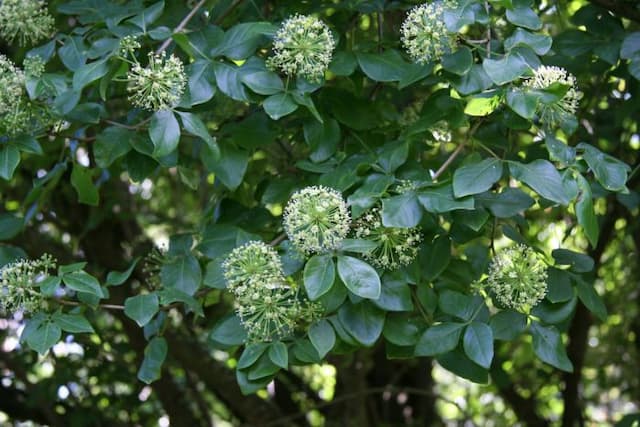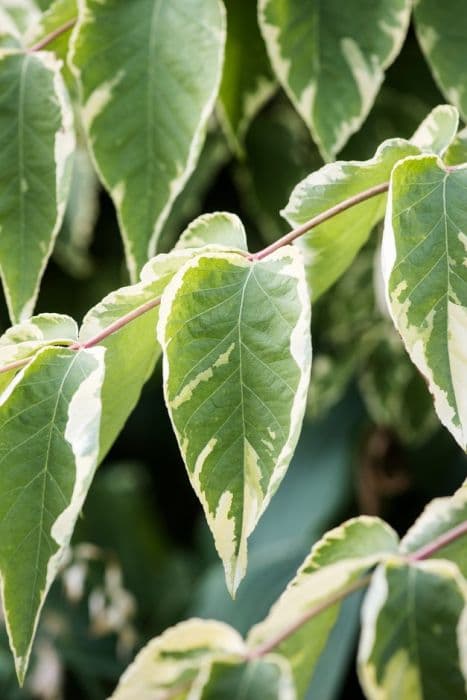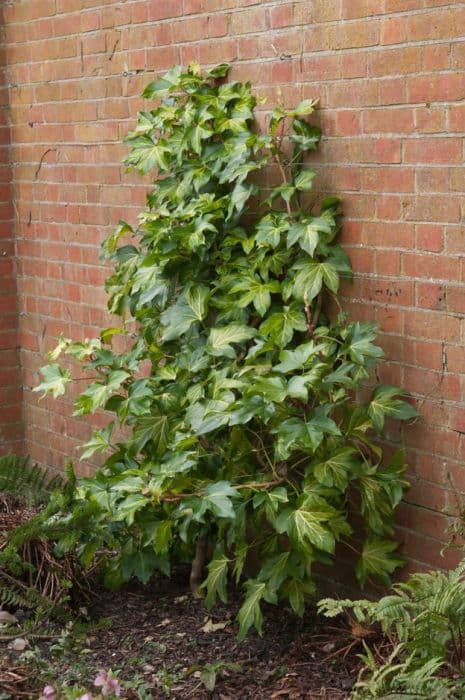English Ivy Hedera helix 'Golden Ingot' (v)

ABOUT
The 'Golden Ingot' English Ivy is a visually striking plant with a lush, trailing growth habit. Its leaves are particularly notable for their unique coloration; young leaves are a bright, golden yellow with green edges, which becomes a rich, green marbled with yellow as they mature. This creates a vivid contrast that can make the plant stand out in any setting. The leaves have a glossy texture and are generally heart-shaped with pointed tips, often with a slight curl that adds to the plant's texture. Its overall appearance gives the 'Golden Ingot' English Ivy a vibrant and attractive aesthetic, with the blend of colors providing visual interest throughout the year. As a variegated variety of English Ivy, it is popular for brightening up indoor spaces as a houseplant, as well as for outdoor containers, hanging baskets, and as a ground cover where it can gracefully cascade.
About this plant
 Names
NamesFamily
Araliaceae
Synonyms
English Ivy, Common Ivy, European Ivy
Common names
Hedera helix 'Golden Ingot'
 Toxicity
ToxicityTo humans
English Ivy (Hedera helix) contains saponins, which can be toxic to humans when ingested. The most common symptoms of English Ivy poisoning include gastrointestinal upset such as abdominal pain, vomiting, and diarrhea. In some cases, oral irritation, excessive drooling, and difficulty swallowing might also occur. Contact with the skin can also cause dermatitis or skin irritation in sensitive individuals. It is essential to prevent ingestion of any part of the plant to avoid these toxic effects.
To pets
English Ivy is also toxic to pets, such as dogs and cats, due to the saponins it contains. If a pet ingests English Ivy, they may exhibit symptoms like vomiting, abdominal pain, hypersalivation, and diarrhea. In some cases, the animal might also suffer from dermatitis if they come into contact with the plant. Consistent with these symptoms, ingestion can lead to severe gastrointestinal distress and, in extreme cases, may require veterinary attention. Pet owners should keep English Ivy out of reach of their pets to avoid accidental consumption.
 Characteristics
CharacteristicsLife cycle
Perennials
Foliage type
Evergreen
Color of leaves
Variegated
Height
6-10 feet (1.8-3 meters)
Spread
3-6 feet (0.9-1.8 meters)
Plant type
Climber
Hardiness zones
5
Native area
Europe
Benefits
 General Benefits
General Benefits- Aesthetic Appeal: The variegated leaves of English Ivy 'Golden Ingot' add visual interest to gardens, walls, and indoor spaces, with its unique golden-yellow to light green foliage that brightens shaded areas.
- Versatility: It can be used in a variety of ways in landscaping, including as a ground cover, climbing vine, or decorative indoor plant, making it a versatile choice for gardeners and decorators.
- Low Maintenance: Once established, English Ivy requires minimal care, making it a convenient option for both novice and experienced gardeners.
- Drought Tolerance: It is relatively drought-tolerant, which is beneficial for gardeners in regions with water restrictions or those looking to reduce their water usage.
- Soil Erosion Control: Its dense growth habit can help prevent soil erosion by stabilizing the soil with its root system.
- Habitat for Wildlife: It provides shelter and food for birds and insects, contributing to biodiversity in the garden space.
- Year-Round Interest: As an evergreen, English Ivy retains its leaves throughout the year, ensuring continuous greenery in the landscape.
 Medical Properties
Medical Properties- This plant is not used for medical purposes.
 Air-purifying Qualities
Air-purifying QualitiesThis plant is not specifically known for air purifying qualities.
 Other Uses
Other Uses- As a Natural Dye: The leaves of English Ivy 'Golden Ingot' can be used to create a natural dye for fabrics, yielding a range of green hues.
- Artistic Impressions: The distinct variegated leaves can be pressed and used in botanical prints or art projects for decorative patterns.
- Ink Production: The leaves, when crushed and mixed with certain solvents, can be utilized to create a natural green ink for calligraphy or artwork.
- Culinary Garnish: Though not widely known for edibility, the young leaves could potentially be used as an ornamental garnish for plating dishes in haute cuisine.
- Enhancing Craft Projects: The vines can be dried and woven into small baskets, wreaths, or used in other craft projects for a rustic touch.
- Decoration in Aquariums: The variegated leaves can add a vibrant aesthetic when placed in aquariums, but the plant must be kept above the waterline as it's not an aquatic plant.
- Biodegradable Mulch: Dried leaves and vine clippings can serve as a natural and decorative mulch for garden beds.
- Educational Tool: The plant can be used in classroom settings to teach students about plant propagation and climber growth habits.
- Festive Decorations: Vines can be arranged into creative shapes or used as greenery for seasonal decorations such as Christmas or Easter.
- Photography Prop: As a prop in photography, the plant's unique golden variegation provides an appealing background or accent in photoshoots.
Interesting Facts
 Feng Shui
Feng ShuiThe English Ivy is not specifically used in Feng Shui practice.
 Zodiac Sign Compitability
Zodiac Sign CompitabilityThe English Ivy is not used in astrology practice.
 Plant Symbolism
Plant Symbolism- Connection and Friendship: Commonly known as English Ivy, this plant often symbolizes strong, enduring connections because of its tendency to interweave and cling to surfaces and other plants.
- Eternal Life: The evergreen nature of English Ivy represents eternity, fidelity, and the immortal soul, which is why it has been used in holiday decorations and religious ceremonies.
- Protection: English Ivy is thought to have protective qualities, possibly due to its use in traditional medicine or its robustness as a plant.
- Growth and Renewal: The vigorous growth pattern of English Ivy signifies renewal and determined growth, often in the face of adversity.
- Survival: The plant's ability to thrive in various conditions associates it with resilience and adaptability.
 Water
WaterEnglish Ivy 'Golden Ingot' prefers consistently moist soil, but it's crucial to allow the top inch of soil to dry out between waterings to prevent root rot. On average, water approximately once a week, but adjust this schedule according to the humidity and temperature of your environment. During active growth in spring and summer, watering might be more frequent, roughly 16 to 32 ounces every week, while in the cooler months, you can reduce it by half. Avoid waterlogging by ensuring the pot has good drainage, and never let the plant sit in stagnant water.
 Light
LightEnglish Ivy 'Golden Ingot' thrives in bright, indirect light, but it can also adapt to medium or low light conditions. It should not be exposed to direct sunlight, particularly in the hot afternoon, as this can scorch the leaves. A spot near a north-facing window or a few feet away from a south or west-facing window is ideal.
 Temperature
TemperatureEnglish Ivy 'Golden Ingot' does best in environments with temperatures ranging from 50 to 70°F. It can tolerate a brief exposure to temperatures as low as 30°F but should not be subjected to frost. To encourage robust growth, avoid placing it in areas with drafts or sudden temperature fluctuations.
 Pruning
PruningPrune English Ivy 'Golden Ingot' to encourage bushier growth, remove dead or damaged foliage, and maintain the desired shape. Best done in spring or early summer, occasional trimming can be performed anytime overly long vines are noticed. Cut back to just above a leaf or node, and don't hesitate to remove up to a third of the length if necessary for size control.
 Cleaning
CleaningAs needed
 Soil
SoilEnglish Ivy 'Golden Ingot' thrives in a well-draining, rich, loamy soil mix with a pH of 5.5 to 6.5. A mix of two parts peat or coir, one part perlite, and one part organic compost or worm castings would provide an ideal environment for root growth and health.
 Repotting
RepottingEnglish Ivy 'Golden Ingot' should be repotted every two years to refresh the soil and accommodate its growth. Younger plants may require more frequent repotting, roughly once a year, while older plants can go a bit longer without being repotted.
 Humidity & Misting
Humidity & MistingEnglish Ivy 'Golden Ingot' prefers high humidity levels, ideally between 40-60%. If indoor air is dry, using a humidifier or a pebble tray with water can help maintain the desirable humidity conditions for this plant.
 Suitable locations
Suitable locationsIndoor
Place in bright, indirect light and maintain high humidity.
Outdoor
Choose shaded area; protect from strong sun and winds.
Hardiness zone
5-11 USDA
 Life cycle
Life cycleEnglish Ivy 'Golden Ingot' (Hedera helix 'Golden Ingot') begins its life cycle with seed germination, where the seeds typically germinate in spring in favorable conditions of moisture and temperature. It then enters into a juvenile vegetative stage, characterized by fast-growing stems with lobed leaves and adventitious roots that allow the plant to climb or spread across the ground. As the plant matures, it transitions to the adult vegetative stage, marked by the development of unlobed, ovate leaves on flowering branches. The plant then reaches the reproductive stage, producing small, greenish-yellow flowers in late summer to fall, which are pollinated by insects. Following pollination, the flowers develop into small, blue-black berries that contain seeds, completing the life cycle as birds and other animals disperse the seeds. Finally, English Ivy may undergo a period of dormancy in colder climates during winter, but in milder regions, it remains evergreen and active throughout the year.
 Propogation
PropogationPropogation time
Spring-Early Summer
Propogation: The English Ivy 'Golden Ingot' is typically propagated through stem cuttings. This method is favored because it's straightforward and the success rate is high. To propagate English Ivy 'Golden Ingot' using this method, it's best to take cuttings during spring or early summer when the plant is actively growing. Cuttings should be about 4 to 6 inches long, with several leaves left on the upper end while removing the lower leaves. The cut end is then dipped in rooting hormone and placed into a pot with well-draining soil, ensuring at least one node is buried where roots can develop. The cutting should be kept under indirect light and consistently moist, but not waterlogged. Roots typically emerge within a few weeks after which the new ivy can be transplanted into a regular potting mix.









